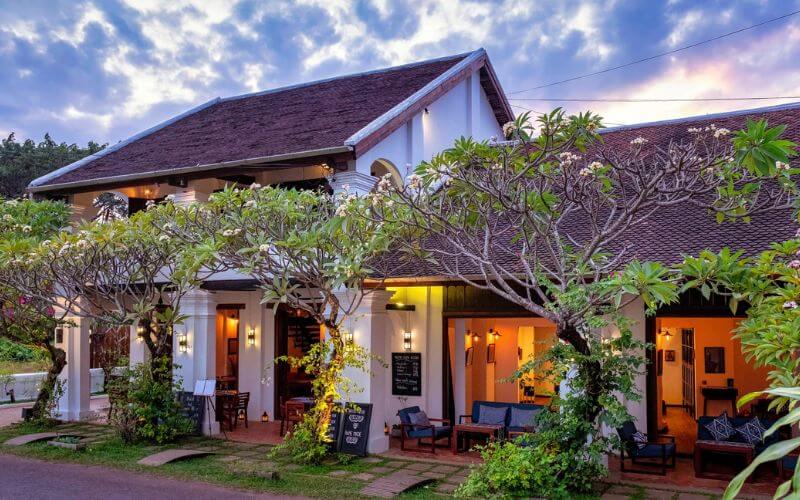The Khmer-period ruins of Wat Phou are located at the base of Mount Phou Kao, some eight kilometers to the southwest of Champassak province. This a is giant complex of temple ruins, rocks, etc., reflecting many cultural and religious values of the ancient Khmer Empire in Laos.
General Information
The miles-long temple complex of Wat Phou was granted its UNESCO World Heritage status in 2001. There was a temple on the site built in the 5th century, but the surviving structures date from the 11th to 13th centuries, constructed by the Khmer Empire, which controlled much of Laos at the time. This giant complex is more than just rocks and ruins, it contains many values in the culture and religion of Laos and the ancient Khmer Empire.
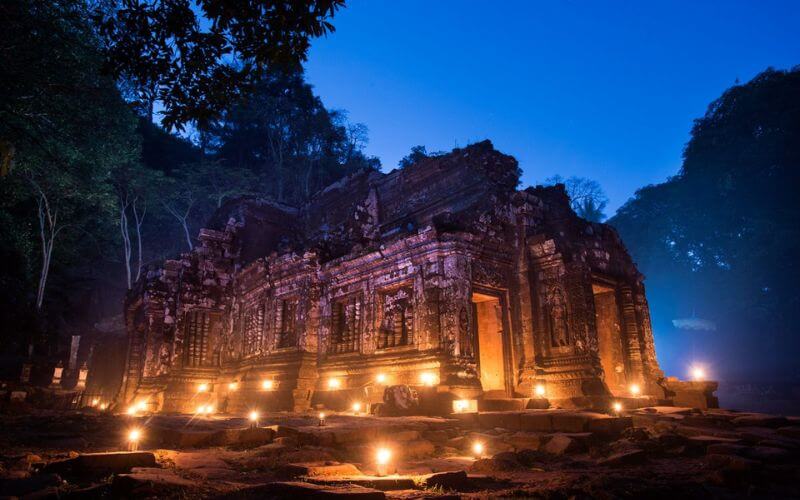
Wat Phou Festival
On the first full moon of the 3rd Lunar month (usually in February), a festival will be held here for 3 days for people to come and offer flowers and incense. The festival attracts lots of monks and Buddhist followers from neighboring countries like Thailand and Cambodia to this sacred area every year.
Best Time to Visit Wat Phou
Wat Phou can be visited year-round, but the rainy season, which runs from May to October, can be hot, humid, and wet. During this time, the temple complex may be more challenging to navigate due to slippery and muddy trails, and the Mekong River may be higher and less accessible.
The best time to visit Wat Phou is during the dry season, which runs from November to March. During this time, the weather is cooler and less humid, making exploring the temple complex and its surroundings more comfortable. The dry season is also the time when the Mekong River is at its lowest, which allows for better views of the temple and surrounding landscapes. Make sure to bring some more clothes in case it can get a bit chilly.
Structure of Wat Phou Complex
Wat Phou was built on seven terraces, align from the Mekong River bank towards the mountain. Starting from 2 barays at the river bank, then a processional walkway, 2 palaces, and then the main sanctuary.
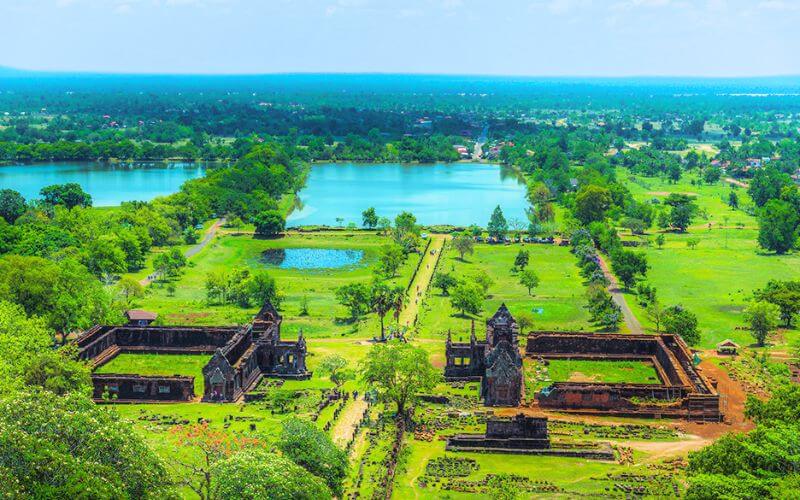
Wat Phou Complex from Above
Barays
In the past, there were several barays, those are huge water reservoirs that symbolize the oceans surrounding Mount Meru, the center of Hindu mythology.
Two Palaces
Continue the processional walkway through the remains of the two palaces, Ho Thao to the South and Ho Nang to the North. The stories said that those palaces were used during many Hindu ceremonies in the 11th century. The lintels and pediments of the 2 are adorned with carvings of Gods like Shiva and his consort Uma on Nandi. Near the South of the palace is a shrine for the sacred bull Nandi.
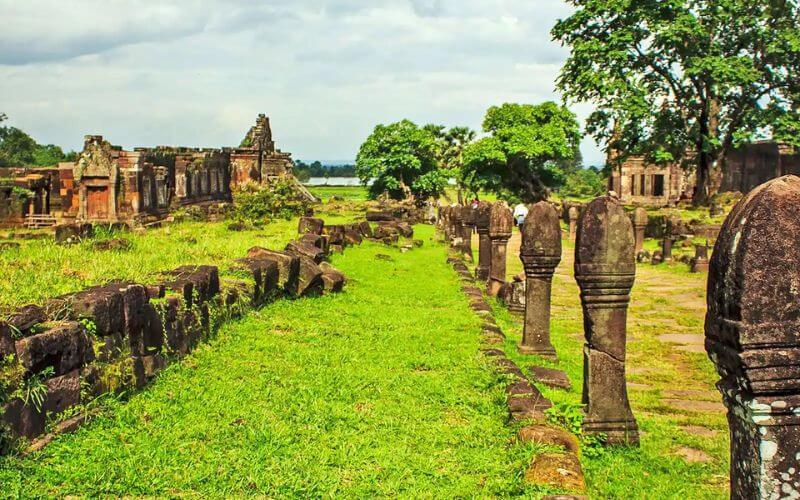
Ruins of The Two Palaces
The Main Sanctuary
From the sanctuary, you can take in the view over the plains. Inside, the sanctuary contains a large Buddha with 3 smaller Buddha images, all dressed in saffron robes. Like many Angkor temples of the same period, the building is adorned with cravings and sculpting of Hindu Gods.
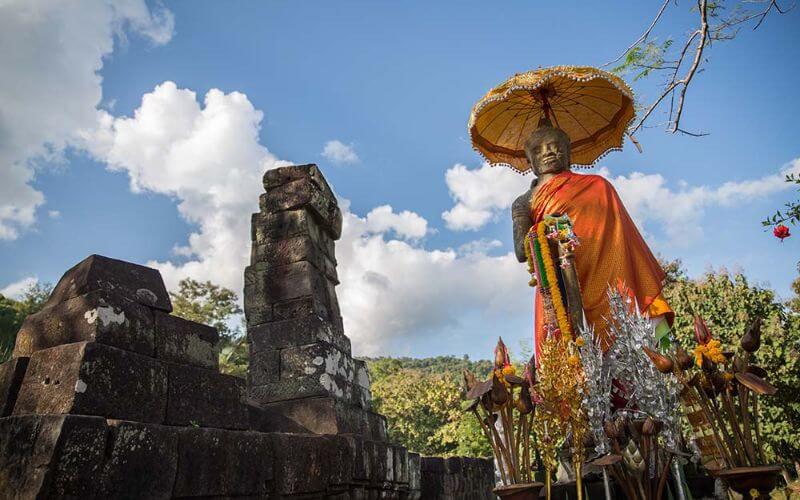
Statue in Wat Phou
Attractions Near Wat Phou
Don Daeng Island
This peaceful island is located in the Mekong River, opposite Champasak town. You can take a ferry or boat from the mainland to Don Daeng and explore the island’s temples, villages, and scenic views. An attraction on the island is the traditional village, where you can learn the local way and culture. The island is famous for waving, pottery, and basketry, visitors can watch the artisans working and purchase their products. It is also a great place to relax with many activities like cycling, hiking, and kayaking, just a ferry trip 10–15 minutes long from Champasak town, this island is the place you shouldn’t miss.
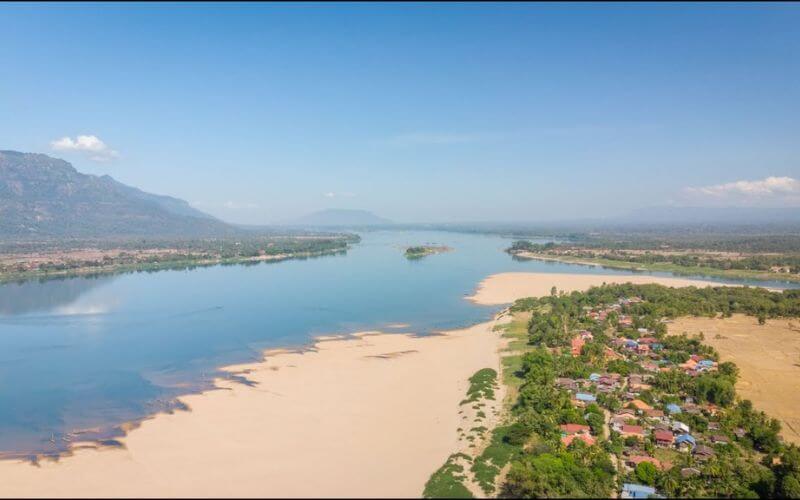
Don Daeng Island
Khone Phapheng Waterfalls
Located about 60 kilometers south of Wat Phou, these waterfalls are the largest and most powerful in Southeast Asia. You can take a boat or bus from Champasak town to reach the waterfalls and enjoy the scenic views and nature trails, walk along several trails, and explore different views of the waterfalls, from above and below. There are also several viewing platforms and picnic areas where visitors can relax and enjoy the scenery. The waterfalls are home to various wildlife, including rare bird species and freshwater dolphins, which can sometimes be seen swimming in the river. The falls are also an important fishing ground for local communities, who use traditional methods to catch fish and shrimp.
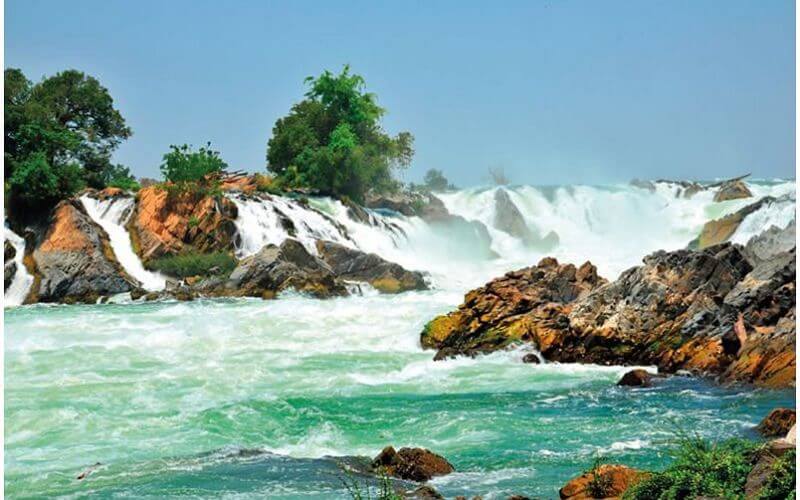
Khone Phapheng Waterfalls
Si Phan Don (4000 Islands)
Si Phan Don, also known as the Four Thousand Islands, is a scenic archipelago located in the Mekong River in southern Laos, near the Cambodian border. It is made up of several islands, the largest of which are Don Det, Don Khon, and Done Khong. The islands are connected by bridges and offer a range of accommodation options, from budget guesthouses to luxury resorts. There are many things you can do here like swimming, kayaking, cycling, and boat tours. The islands are known for their serene and relaxed atmosphere, and visitors can spend their days exploring the villages, relaxing on the riverbanks, or watching the river dolphins swim by.
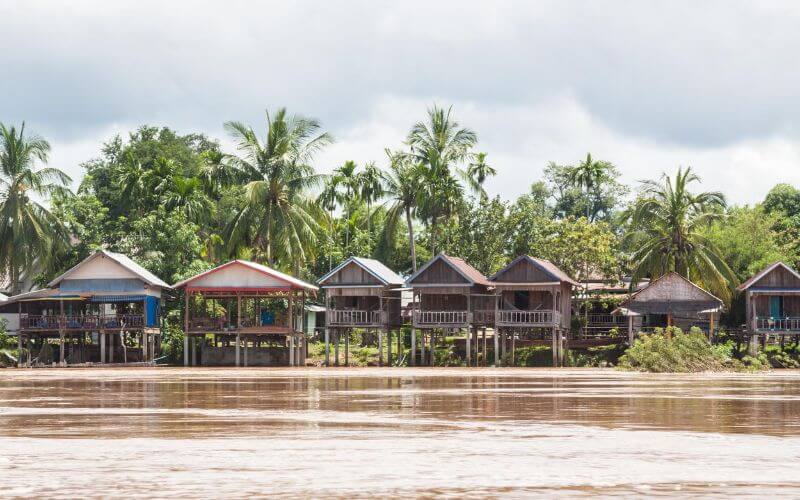
Si Phan Don Islands
Bolaven Plateau
The Bolaven Plateau is a scenic upland region located east of Pakse, known for its beautiful waterfalls, coffee plantations, and traditional villages. The Bolaven Plateau is home to several beautiful waterfalls, including the Tad Fane, Tad Lo, and Tad Yuang waterfalls, which are popular destinations for visitors. You can tour the plantations, learn about the coffee-making process, and sample some of the local coffee. In addition to waterfalls and coffee plantations, the Bolaven Plateau is home to several traditional villages, where people can experience the local way of life and culture. The villages are known for their weaving, pottery, and basketry, and visitors can watch the artisans at work and purchase their products. The Plateau is an ideal spot for hiking and trekking, with trails through the land and stunning views along the way.
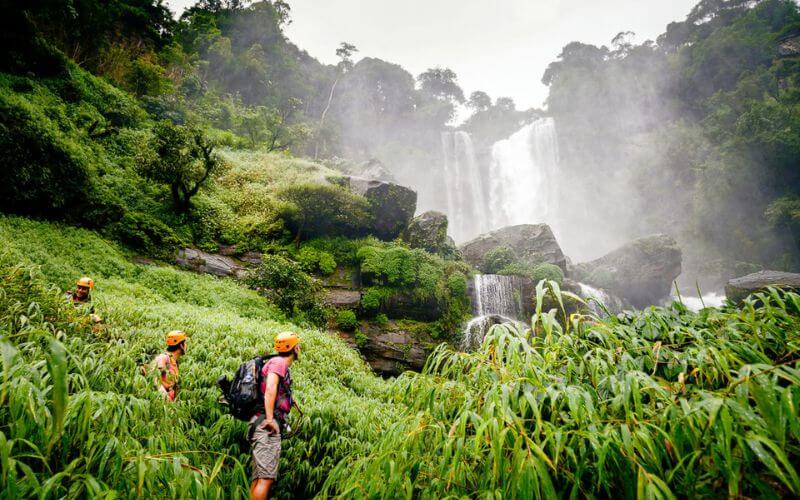
Bolaven Plateau
How to Get to Wat Phou
Wat Phou is located in Champasak Province, southern Laos, and getting there involves a combination of travel options, depending on your starting point. Getting there involves taking a combination of transportation modes such as air, bus, tuk-tuk, and boat, depending on your starting point and preferences.
By Plane
The nearest airport to Wat Phou is Pakse International Airport, located about 30 kilometers north of the temple complex. You can take a flight from Vientiane, the capital of Laos, or from neighboring countries such as Thailand, Cambodia, and Vietnam. From the airport, you will take a taxi or tuk-tuk to Wat Phou, which takes around 45 minutes.
By Bus
Pakse is well-connected by bus to other cities and towns in Laos, including Vientiane, Luang Prabang, Savannakhet, and Si Phan Don (4000 Islands). From Pakse, you can take a local bus or minivan to Wat Phou, which takes about 30–45 minutes. The ticket will cost around 50,000-100,000 Kips ($5-10 USD).
By Tuk-tuk
You can also hire a tuk-tuk (a three-wheeled motorized vehicle) from Pakse or nearby towns to take you to Wat Phou. This is a popular option for those who want to explore the temple complex and surrounding areas at their own pace. The price for a tuk-tuk ride may vary, depending on your negotiating skills.
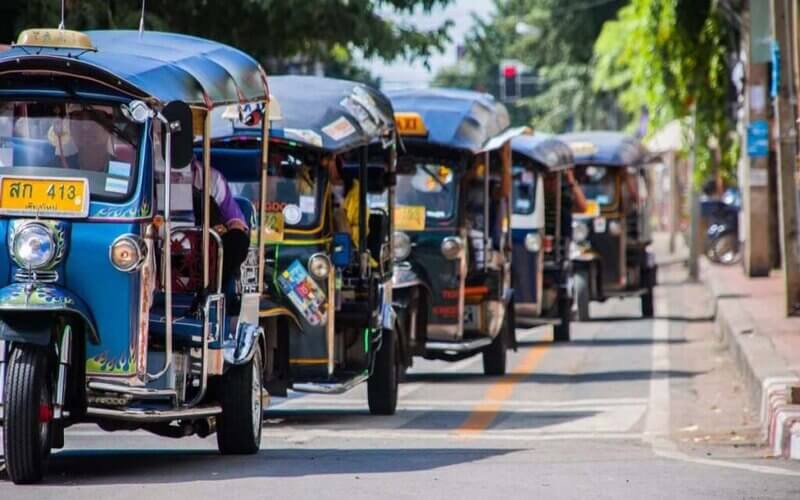
Tuk-tuk
By Boat
Another option is to take a boat from Pakse or Don Det (one of the 4000 Islands) to Champasak, which is the closest town to Wat Phou. From there, you can take a tuk-tuk or taxi to reach the temple complex. The price for a shared ride is 50,000-100,000 Kips ($5-10 USD) per person and 500,000-1,500,000 Kips (nearly $50-150USD) for a private boat, still, this price may change due to the time you are traveling, the size of the boat, etc.
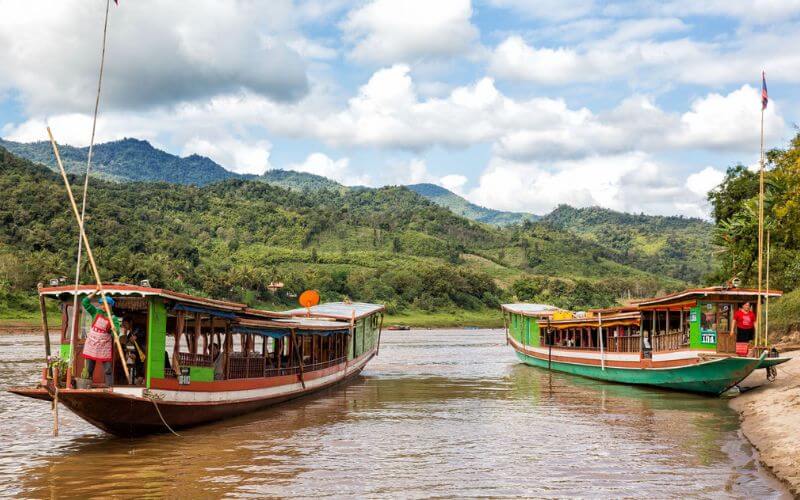
Boats to Wat Phou
Accommodation in Wat Phou
Champasak Province is also popular for tourism and there are many options for you when it comes to accommodation, they have guest houses, homestays, and hotels too, some of the most popular are:
- The River Resort
- Jenda the Views
- Residence Bassac

Residence Bassac
Things You Need to Know Before Visiting Wat Phou
Dress code
This is still a religious site and like many others, you must dress politely, no need to be fancy because you will have to hike up to the main temple on top, just cover your shoulder and your knees. A good pair of hiking shoes are highly recommended.

Dress code When Visit a Temple
Preparations
- Sunscreen
- A hat to protect you from the sun
- Water
Lastly, do not take pictures of others without their permission, and don’t touch the statues.
These things help you plan your trip to Wat Phou, Laos. Don’t hesitate to contact us and customize your tour to Laos with all the best.
